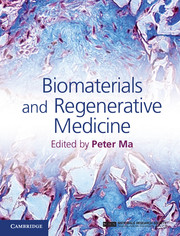Book contents
- Frontmatter
- Contents
- List of contributors
- Preface
- Part I Introduction to stem cells and regenerative medicine
- Part II Porous scaffolds for regenerative medicine
- 7 Nanofibrous polymer scaffolds with designed pore structure for regeneration
- 8 Electrospun micro/nanofibrous scaffolds
- 9 Biological scaffolds for regenerative medicine
- 10 Bioceramic scaffolds
- 11 Collagen-based tissue repair composite
- 12 Polymer/ceramic composite scaffolds for tissue regeneration
- 13 Computer-aided tissue engineering for modeling and fabrication of three-dimensional tissue scaffolds
- Part III Hydrogel scaffolds for regenerative medicine
- Part IV Biological factor delivery
- Part V Animal models and clinical applications
- Index
- References
8 - Electrospun micro/nanofibrous scaffolds
from Part II - Porous scaffolds for regenerative medicine
Published online by Cambridge University Press: 05 February 2015
- Frontmatter
- Contents
- List of contributors
- Preface
- Part I Introduction to stem cells and regenerative medicine
- Part II Porous scaffolds for regenerative medicine
- 7 Nanofibrous polymer scaffolds with designed pore structure for regeneration
- 8 Electrospun micro/nanofibrous scaffolds
- 9 Biological scaffolds for regenerative medicine
- 10 Bioceramic scaffolds
- 11 Collagen-based tissue repair composite
- 12 Polymer/ceramic composite scaffolds for tissue regeneration
- 13 Computer-aided tissue engineering for modeling and fabrication of three-dimensional tissue scaffolds
- Part III Hydrogel scaffolds for regenerative medicine
- Part IV Biological factor delivery
- Part V Animal models and clinical applications
- Index
- References
Summary
Introduction
Polymer nanofibers have several properties that make them an extremely promising material in regenerative medicine. These favorable properties are derived from their high surface-area-to-volume ratios, their size relationship to that of cells, and their geometric similarity to natural extracellular matrix (ECM) fibers such as collagen. The literature in the field of tissue engineering generally defines nanofibers as those with diameters less than 1000 nm, while fibers larger than that are described as microfibers. The high surface-area-to-volume ratio of nanofibers allows them to interact with biomolecules at very high efficiency. In addition, nanofibers and microfibers are valuable in tissue engineering because their size is suitable for assembling complex three-dimensional (3D) architectures that can be perceived and populated by cells.
It has become increasingly apparent that cell behaviors are highly dependent on the physical environment. Substrate microstructure cues such as size, orientation, and dimensionality modulate cell behaviors ranging from attachment and morphology to differentiation and ECM production. Specifically, it has been shown that polymer nanofibrous structures can improve cell attachment; increase cell viability, proliferation, and ECM production; and predictably push cells toward specific morphologies and differentiation paths [1]. Researchers have been exploring ways of designing polymer nanofiber scaffolds that elicit desired cell responses for specific tissue engineering applications. The vast majority of these designs start with the electrospinning fabrication method. The electrospinning method is a simple and relatively inexpensive process, yet demonstrates amazing versatility in terms of the types of fibers and structures that can be fabricated. This chapter will introduce the basics of electrospinning and describe in detail strategies to make nanofiber structures for tissue engineering applications. These strategies will be focussed on electrospinning fibers with desired biofunctionality, electrospinning fiber arrays with uniaxial alignment, and methods of assembling individual fibers into 3D scaffolds conducive to cell population. It is our hope that the tools presented here can be used to design better electrospun scaffolds for applications in regenerative medicine.
- Type
- Chapter
- Information
- Biomaterials and Regenerative Medicine , pp. 104 - 132Publisher: Cambridge University PressPrint publication year: 2014



